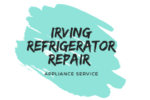We are Irving Refrigerator repair, an appliance repair company in Irving,TX. Here is another interesting article from the book called “MAJOR HOME APPLIANCES A COMMON SENSE REPAIR MANUAL” by “DARELL L.RAINS” about How Refrigerator and Ice Maker works?
The home repairmen should be very cautious when it comes to repair of the household refrigerator. They should be aware of the fact that they are dealing with a very expensive product, and one that contains a very delicately balanced cooling system. One small error could damage the system beyond repair.
There are some repairs that readers should never attempt. Replacing a faulty compressor requires special vacuum and Freon filling equipment that only professional technicians can handle.
The refrigerator cooling system is not like the family automobile air conditioner. You can’t simply attach a hose and add a little Freon when it isn’t cooling properly. The refrigerator is a carefully balanced, sealed system, and normally should not have a Freon-loss problem. If the unit is not cooling properly, and you have determined that the compressor is running, then there are several electrical components in the system that could be at fault.
These are parts that the homeowner can test and replace with relative ease by following the instructions in this guide.
Often the problem is found in the defrost circuit. Most homeowners are not aware of the fact that the so-called “frost-free” refrigerator is really just an old-style refrigerator with a new twist. For many years we lived with frost buildup in the freezer compartment of the old-style units until finally we shut the machine off, opened the freezer, door and let the frost melt and drain to the bottom of the machine.
The new frost-free refrigerator does basically the same thing, but it does it automatically on a timed sequence. The defrost timer shuts OFF the compressor/cooling circuit and activates a metal rod that quickly heats the freezer compartment to approximately 70 degrees F. Frost on the hidden evaporator coil melts and drains into a pan at the bottom of the refrigerator. (You never have to empty the pan, however, because the water evaporates between defrost cycles). The frost is removed and the machine is back on before your frozen lamb chops even start to thaw.
When the defrost timer fails, you can actually have the compressor trying to cool the freezer compartment at the same time that the defrost heater is almost growing red. Later in this chapter we describe all the steps necessary to examine the defrost cycle components and to isolate and repair faulty parts.
One final word of caution in working on the household refrigerator: do not use a hair dryer to remove frost build-up in a freezer compartment. Use a pan of hot water to speed up the process if desired.
THE REFRIGERATOR – HOW IT WORKS
All household refrigerator require 110-to-125-volt electricity. The refrigerator compressor receives refrigerant vapor from the suction line in the low side of the unit where it is compressed and then sent through the discharge line into the condenser. The condenser is located either under the refrigerator cabinet or on the back of the cabinet. As the vapor enters the condenser, it contains heat. The condenser removes the heat, either by convection or forced air. As the refrigerant vapor passes through the condenser and is cooled, it condenses to a liquid.
The refrigerant, which is now a liquid, passes from the condenser into the liquid line, where it flows back into the refrigerator cabinet. The liquid refrigerant then enters a restrictor tube, which is a length of tubing of very small diameter. A small flow of refrigerant is allowed to enter the evaporator, which has tubing of much larger diameter. This allows the refrigerant to expand.
As the refrigerant travels through the evaporator, it absorbs heat through evaporation and super cools the coils. Toward the end of the evaporator tubing, the refrigerant turns to gas and warms again. This warm refrigerant vapor then passes into the suction line and into the compressor, where the refrigeration cycle starts all over again.
As the refrigerant circulates throughout the system, it eventually cools the refrigerator and freezer sections to the desired temperature. If the refrigerator compressor operated continuously, the temperature inside the refrigerator cabinet would soon freeze everything. Therefore, the refrigerator cycles ON and OFF through signals from a thermostat. Figure 209 shows the refrigerant flow pattern during the complete cooling cycle of a typical household refrigerator.
Refrigerator/Freezer Combination
Most refrigerators being sold and serviced today are refrigerator/freezer combinations. These models usually contain two separate compartments fully insulated using urethane foam or fiberglass. Each compartment operates at a different temperature. The refrigerator section is maintained at a temperature selected by control and ranging from 38 to 42 degrees F. The temperature in the freezer section is normally fixed at or near 0 degrees F.
While it may appear that a refrigerator/freezer combination has two evaporators, it actually has only one set of cooling coils. The evaporator coil is located in the freezer section, and it is here that the refrigerant enters the evaporator, chills the coils, and drops the temperature to 0 degrees. Cold air is circulated over the coils and throughout the freezer by the evaporator fan motor.
Temperature in the refrigerator section of the appliance is controlled by a mechanical baffle that allows cold air from the freezer section to enter an air duct, which forces cold air into the refrigerator section. Adjustment of the air control varies the desired temperature from 38 to 42 degrees.
Household Freezers
The household freezer works on the same principle as the refrigerator, with the exception that the temperatures in a freezer are approximately 40 degrees lower than those of a refrigerator. Because the mechanical systems are so similar, the household freezer will not be discussed in this service guide.
THE ICEMAKER-HOW IT WORKS
The water supply that is controlled by a water inlet valve enters the mold cavity of the compact ice maker. The water then freezes in the ice maker mold. An electric heater thaws the frozen ice crescents so that they can be ejected from the mold. An electric motor then drives an ejector blade through a cam assembly, which frees the released crescents. The crescents revolve in a clockwise rotation and tumble into the ice storage bin.
Continue reading about “Freezer Repair“


